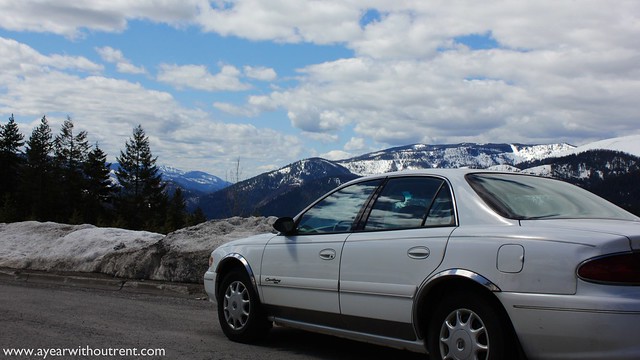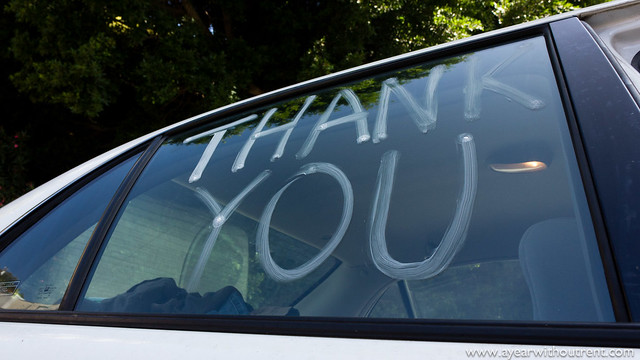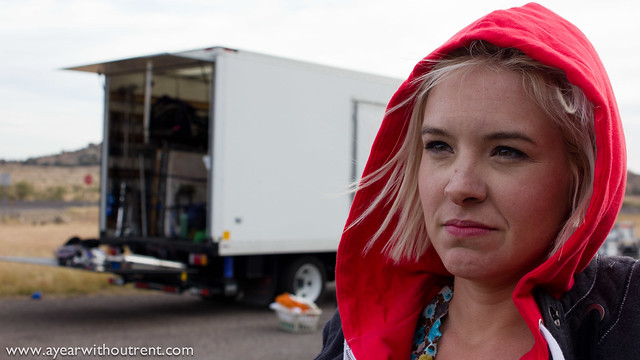
It started off as a gift.
I was car-less, living in a city where you could conceivably get around without one, when my father called to tell me he was getting a new(er) vehicle and did I want his old one?
"How much do you want for it?" I asked.
"No, do you want it?"
"Oh. Yeah, sure. Thanks."
This was back in 2007 and the old car was a white 1999 Buick Century, a solid car, nothing flashy about it. But, more importantly, able to go from point A to point B reliably.
I drove it back to Pennsylvania that summer and half-way there the "Service Engine Soon" light came on.
"Don't worry about it," Dad said. "It does that all the time."
It's been on ever since.
Two months later it sprung a coolant leak, and by the time they found it, it had taken two weeks and $3,000, so you could say I got the car for three grand, which is still a pretty good deal. Other than that, it's been reliable. I had a scary moment in New York when I thought it was going to die in a downpour on a busy highway, but it turned out the spark plugs just needed to be replaced.
I'm a little paranoid about cars. I haven't a clue how to fix them. I can change a tire in a pinch, but I can't change the oil. If something goes wrong, I take it to a mechanic, which is a worry because they always seem to find something else wrong with it and I'm not exactly swimming in the cash needed to fix it. But my Buick Century held up as I drove it around the Northeast. It never stranded me at a rest area. I never had to tow it. It passed every inspection. It was solid.
And then my life fell apart.
The Buick sat for a couple months in a parking garage in Pittsburgh while I went looking for rock bottom. I wrote a script called "Suicide is Painless". I drank a lot of whiskey. When I got back to the Buick, I put everything I owned in it and drove it back across the Northeast.
This was in 2010. This was the start of my nomadic lifestyle.
That summer I made a movie. And then I came up with this crazy idea to travel around the country, working on other people's movies. I got the idea funded on Kickstarter. I changed my address to "1 Buick Century, Anytown, USA", much to the displeasure of AT&T. I put some stuff in storage. And once again I loaded everything I owned into the car and drove. And drove. And drove. And drove.
Somewhere in Minnesota, my brother called and asked how the car was holding up. I told him it was doing fine and he seemed a little surprised. I kept going. I drove across Montana to Seattle, then up into Canada. I went down to LA, then back up to Seattle. I had arguments with the woman on my GPS. I got a little stir-crazy. The pile of empty coffee cups on the floor of the passenger seat got deeper. I hung festival passes from the rear view mirror like trophies. I lived out of the car, working out a rotation of clothes in the back seat. I kept the whiskey in the trunk.

In Seattle, some asshole broke the window looking for something to steal. Luckily they didn't find anything. Victoria Westcott rallied the beautiful people of the internet to raise the money to get it fixed before she had to join me in a jaunt back down to LA. They raised $300 in a day. On the way down the coast, Victoria drove for a couple of hours. It was the first time I'd ever sat in the passenger seat. It felt weird.
I drove to Vegas, to Denver, to Kansas City, then back up to Minnesota. I nearly got lost in the woods in Arkansas. Then I headed to Texas. I went to Marfa, where Brea Grant, Stacey Storey, and I drank Willie Nelson whiskey straight out one of the bottles in the trunk at 2am. I raced east to South Carolina. I drove past my old apartment in Chattanooga and it felt like I was taking a tour of someone else's life. I made it all the way back to New England and the car was still fine.
That was almost a year ago. Half my stuff is still in that car. I'm still a nomad living at 1 Buick Century, Anytown, USA.
The other day, the brake pedal suddenly went all the way to the floor. Thankfully, I was only 3 miles away from where I'm staying and was able to make it back ok. I opened the hood and noticed all the brake fluid was gone. So I took it to a shop. They called back the next day and the mechanic asked me how long I was planning to keep the car.
This is why I get paranoid about mechanics.
The rear suspension is "rotted out". The brake line is leaking in two places. The fuel line is leaking too. He listed a few more issues. My father went and looked at it on the lift.
He summed it up like this: "I have good news and I have good news. First, I got you a beer. Second, you probably don't have to worry about getting your brakes fixed."
The Buick is sitting now. I still have clothes in it. There's an air mattress in the back seat. There's a case of ramen noodles in the trunk. I drank all the whiskey. We're going to put it in the garage and see if we can't salvage it, wring a few more months of use out of it. Fixing it may just cost more than the car is worth. So, essentially this is the death rattle of my 1999 Buick Century. I slept in that car. Hell, I lived in that car. More than an apartment, even, it feels like an extension of myself, my mobile security blanket with a bitchy voice on the GPS and a case of beer in the trunk for when I reach my destination. Only, this might be the Buick's destination--the garage from which I picked it up 6 years ago.
Six years. That's the longest I've lived anywhere since I was a kid. Someone on Facebook pointed out that I could probably still sleep in it, but what's the point if it can't go anywhere?
The Buick doesn't owe me a thing. It's the best car I've ever owned
Looks like it's time to move.

Lucas McNelly is the filmmaker behind A YEAR WITHOUT RENT, UP COUNTRY, BLANC DE BLANC, and GRAVIDA. He consults on Kickstarter campaigns for a living. He hasn’t lived anywhere in a long time.


















